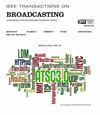Multi-Level Perception Assessment for Underwater Image Enhancement
IF 4.8
1区 计算机科学
Q2 ENGINEERING, ELECTRICAL & ELECTRONIC
引用次数: 0
Abstract
Due to the complex underwater imaging environment, existing Underwater Image Enhancement (UIE) techniques are unable to handle the increasing demand for high-quality underwater content in broadcasting systems. Thus, a robust quality assessment method is highly expected to effectively compare the quality of different enhanced underwater images. To this end, we propose a novel quality assessment method for enhanced underwater images by utilizing multiple levels of features at various stages of the network’s depth. We first select underwater images with different distortions to analyze the characteristics of different UIE results at various feature levels. We found that low-level features are more sensitive to color information, while mid-level features are more indicative of structural differences. Based on this, a Channel-Spatial-Pixel Attention Module (CSPAM) is designed for low-level perception to capture color characteristics, utilizing channel, spatial, and pixel dimensions. To capture structural variations, a Parallel Structural Perception Module (PSPM) with convolutional kernels of different scales is introduced for mid-level perception. For high-level perception, due to the accumulation of noise, an Adaptive Weighted Downsampling (AWD) layer is employed to restore the semantic information. Furthermore, a new top-down multi-level feature fusion method is designed. Information from different levels is integrated through a Selective Feature Fusion (SFF) mechanism, which produces semantically rich features and enhances the model’s feature representation capability. Experimental results demonstrate the superior performance of the proposed method over the competing image quality evaluation methods.水下图像增强的多级感知评价
由于水下成像环境的复杂性,现有的水下图像增强(UIE)技术无法满足广播系统对高质量水下内容日益增长的需求。因此,需要一种鲁棒的质量评估方法来有效地比较不同增强后的水下图像的质量。为此,我们提出了一种利用网络深度不同阶段的多层次特征对增强水下图像进行质量评估的新方法。我们首先选取具有不同失真的水下图像,分析不同特征层次上不同UIE结果的特征。我们发现,低级特征对颜色信息更敏感,而中级特征更能表明结构差异。在此基础上,设计了通道-空间-像素注意模块(channel - spatial - pixel Attention Module, CSPAM),利用通道、空间和像素维度对颜色特征进行低层次感知。为了捕获结构变化,引入了具有不同尺度卷积核的并行结构感知模块(PSPM)用于中级感知。对于高级感知,由于噪声的积累,采用自适应加权降采样(AWD)层来恢复语义信息。在此基础上,设计了一种自顶向下的多层次特征融合方法。通过选择性特征融合(Selective Feature Fusion, SFF)机制整合不同层次的信息,生成语义丰富的特征,增强了模型的特征表示能力。实验结果表明,该方法具有较好的图像质量评价效果。
本文章由计算机程序翻译,如有差异,请以英文原文为准。
求助全文
约1分钟内获得全文
求助全文
来源期刊

IEEE Transactions on Broadcasting
工程技术-电信学
CiteScore
9.40
自引率
31.10%
发文量
79
审稿时长
6-12 weeks
期刊介绍:
The Society’s Field of Interest is “Devices, equipment, techniques and systems related to broadcast technology, including the production, distribution, transmission, and propagation aspects.” In addition to this formal FOI statement, which is used to provide guidance to the Publications Committee in the selection of content, the AdCom has further resolved that “broadcast systems includes all aspects of transmission, propagation, and reception.”
 求助内容:
求助内容: 应助结果提醒方式:
应助结果提醒方式:


